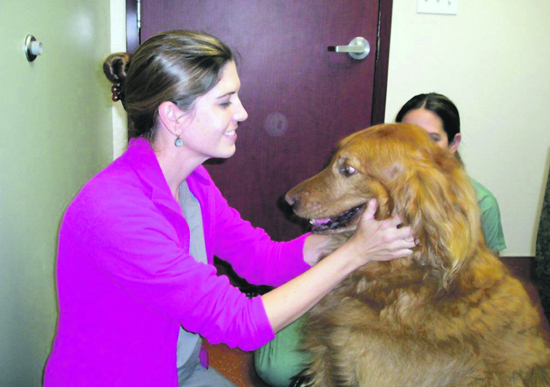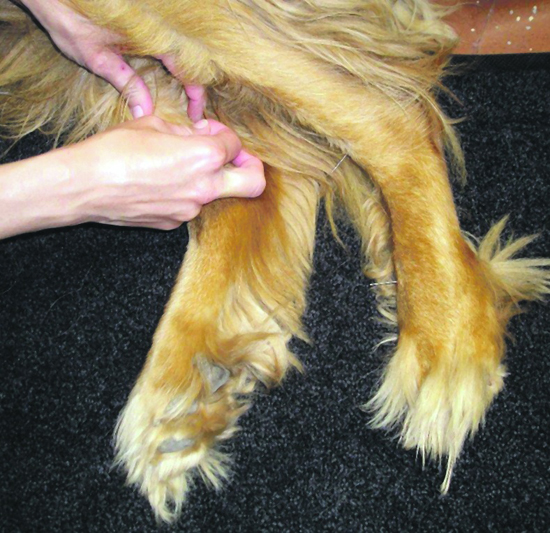| | Published August 15th, 2012
| Alternative Medicine for Pets: A Personal Look
| | Cathy Dausman |  | | Midas greets Jamie Peyton, DVM, before acupuncture treatment. Photos Cathy Dausman
|
Midas is our Golden Retriever. He's a long-legged 8-year-old, weighs 85 solid pounds, eats enthusiastically, sleeps (sometimes snores) with great abandon, and loves to chase squirrels. We weren't overly concerned when he developed a limp last fall in his front left leg (serves him right for constantly vaulting over our backyard slope), but x-rays showed he had cancer, most likely osteosarcoma, or OSA. With or without treatment, expected life span for a dog with that diagnosis is 6 to 18 months.
 Our family has kept Golden Retrievers for 20 years. Our first was a red coated, gentle soul who lived to the age of 13 and died with quiet dignity. This dog, our current companion, must be nature's payback in a perverse Murphy's Law sort of way. He does not have the golden's "soft mouth." Our hairy beast is terribly stubborn and overly physically. He once made an off-leash mad dash toward my husband, head-butted his master's leg, and broke it in two places. No malice aforethought; just "I'm very glad to see you!"
Our family has kept Golden Retrievers for 20 years. Our first was a red coated, gentle soul who lived to the age of 13 and died with quiet dignity. This dog, our current companion, must be nature's payback in a perverse Murphy's Law sort of way. He does not have the golden's "soft mouth." Our hairy beast is terribly stubborn and overly physically. He once made an off-leash mad dash toward my husband, head-butted his master's leg, and broke it in two places. No malice aforethought; just "I'm very glad to see you!"
 Despite great strides in research and treatment, cancer in humans and animals is still a diagnosis that stuns. And how do you explain a life-shortening diagnosis or soothe a four legged friend while treatments ensue?
Despite great strides in research and treatment, cancer in humans and animals is still a diagnosis that stuns. And how do you explain a life-shortening diagnosis or soothe a four legged friend while treatments ensue?
 Veterinarians at two hospitals laid out our dog's many options: radiation and chemotherapy, limb amputation and chemotherapy, or limb spare surgery (damaged bone is removed and the remaining ends splinted between metal plates). Palliative care options included monthly Pamidronate (a human osteoporosis drug) infusions, or simply treating symptoms with anti-inflammatory drugs and narcotics.
Veterinarians at two hospitals laid out our dog's many options: radiation and chemotherapy, limb amputation and chemotherapy, or limb spare surgery (damaged bone is removed and the remaining ends splinted between metal plates). Palliative care options included monthly Pamidronate (a human osteoporosis drug) infusions, or simply treating symptoms with anti-inflammatory drugs and narcotics.
 While financial constraints were part of our decision, because the dog was and still is so physically active, we decided against amputation, chemotherapy or radiation. At one vet's suggestion, we tried acupuncture. Welcome to the world of Eastern medicine for pets.
While financial constraints were part of our decision, because the dog was and still is so physically active, we decided against amputation, chemotherapy or radiation. At one vet's suggestion, we tried acupuncture. Welcome to the world of Eastern medicine for pets.
 Four Seasons Animal Hospital's Dr. Wendy Wallace explains that Traditional Chinese Veterinary Medicine (TCVM) is "so much more mainstream" than western medicine because it was derived several thousand years ago. TCVM consists of five energy modalities: acupuncture, t'ai chi, food therapy, herbal, and tui na, or manipulative treatment, which may also be known as chiropractic or massage therapy. These treat the animal's whole body as opposed to treating symptoms.
Four Seasons Animal Hospital's Dr. Wendy Wallace explains that Traditional Chinese Veterinary Medicine (TCVM) is "so much more mainstream" than western medicine because it was derived several thousand years ago. TCVM consists of five energy modalities: acupuncture, t'ai chi, food therapy, herbal, and tui na, or manipulative treatment, which may also be known as chiropractic or massage therapy. These treat the animal's whole body as opposed to treating symptoms.
 The practice of chiropractic medicine on animals really began in the equine community. "If you're riding a horse, you know when his gait is off," Wallace says. From there, the practice spread to working dogs, then to the general canine population. "Anything that has a nervous system," Wallace says, including dogs, cats, birds, rabbits, and reptiles, can benefit.
The practice of chiropractic medicine on animals really began in the equine community. "If you're riding a horse, you know when his gait is off," Wallace says. From there, the practice spread to working dogs, then to the general canine population. "Anything that has a nervous system," Wallace says, including dogs, cats, birds, rabbits, and reptiles, can benefit.
 When Wallace first began suggesting animal TCVM treatments 15 years ago, she says people looked at her like she "had a third eye." Today 80 percent of her practice is devoted to alternative medicine. Wallace has even treated a pet bat with acupuncture. Now our own batty dog is being treated with acupuncture, and is responding well. We also tried herbal supplements, but quickly discontinued them when neither the dog nor his owners liked the smell!
When Wallace first began suggesting animal TCVM treatments 15 years ago, she says people looked at her like she "had a third eye." Today 80 percent of her practice is devoted to alternative medicine. Wallace has even treated a pet bat with acupuncture. Now our own batty dog is being treated with acupuncture, and is responding well. We also tried herbal supplements, but quickly discontinued them when neither the dog nor his owners liked the smell!
 Our acupuncture treatment with Dr. Jamie Peyton starts with a brief dog wellness checkup, and reciprocal nose and face-lick greeting to the vet. With the dog on his side, Peyton inserts 12 to 18 human grade acupuncture needles on his head, back and legs. Wallace says animals in for first-time treatments are "guarded," but become more relaxed and more willing patients over time. Installation takes 10 to 15 minutes; the patient is then left to rest for another 20.
Our acupuncture treatment with Dr. Jamie Peyton starts with a brief dog wellness checkup, and reciprocal nose and face-lick greeting to the vet. With the dog on his side, Peyton inserts 12 to 18 human grade acupuncture needles on his head, back and legs. Wallace says animals in for first-time treatments are "guarded," but become more relaxed and more willing patients over time. Installation takes 10 to 15 minutes; the patient is then left to rest for another 20.
 Eight-plus months out from original diagnosis, and four months into acupuncture, Midas has managed to gain weight, become less lame and has regained once atrophied shoulder muscle.
Eight-plus months out from original diagnosis, and four months into acupuncture, Midas has managed to gain weight, become less lame and has regained once atrophied shoulder muscle.
 Peyton says Midas's care is really a "one day at a time approach" and he remains at risk for a leg fracture or lung metastasis, but going many months post diagnosis is "excellent."
Peyton says Midas's care is really a "one day at a time approach" and he remains at risk for a leg fracture or lung metastasis, but going many months post diagnosis is "excellent."
 "The goal of palliative care is always to control pain and lameness," she says, "and he has been doing very well with his acupuncture and daily pain medication. He really is an inspiration for other people with dogs with long bone OSA that chose palliative therapy."
"The goal of palliative care is always to control pain and lameness," she says, "and he has been doing very well with his acupuncture and daily pain medication. He really is an inspiration for other people with dogs with long bone OSA that chose palliative therapy."
 Midas lives with cancer daily, but he is also enjoying a high quality of life. And that, say Wallace and Peyton, is what it's all about.
Midas lives with cancer daily, but he is also enjoying a high quality of life. And that, say Wallace and Peyton, is what it's all about.

|
 | | Needles are gently inserted into the very hairy dog
| | | | | | | | | | | Advertisement | | |
| | | print story
Before you print this article, please remember that it will remain in our archive for you to visit anytime.
download pdf
(use the pdf document for best printing results!) | | | Comments | | |
| | | | | | | | | | | | | | | | |



